
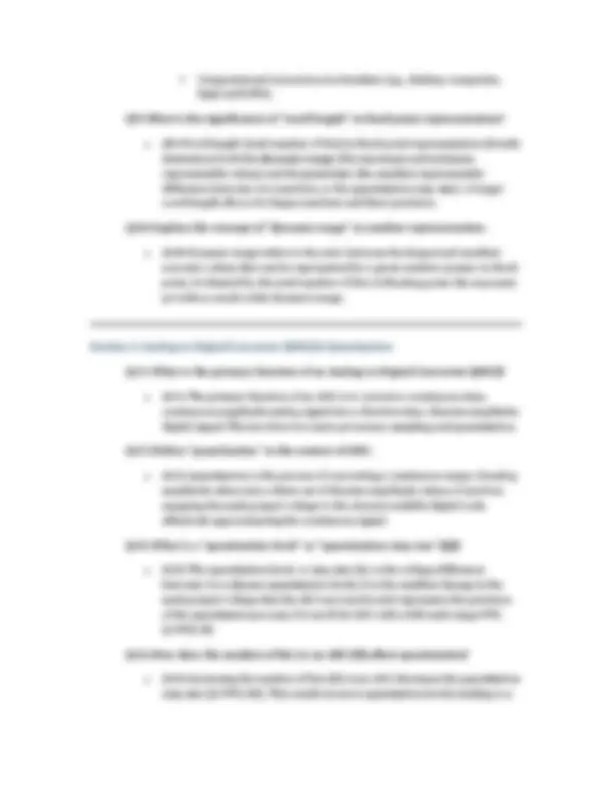
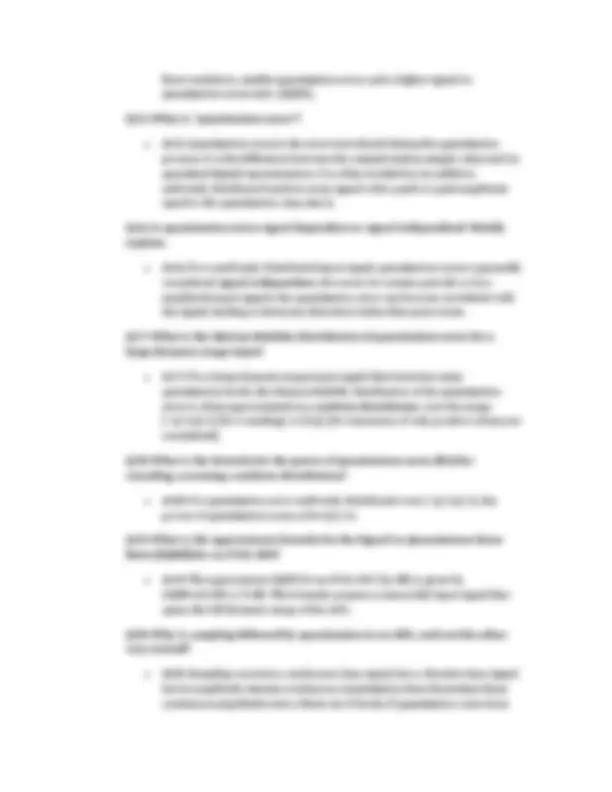
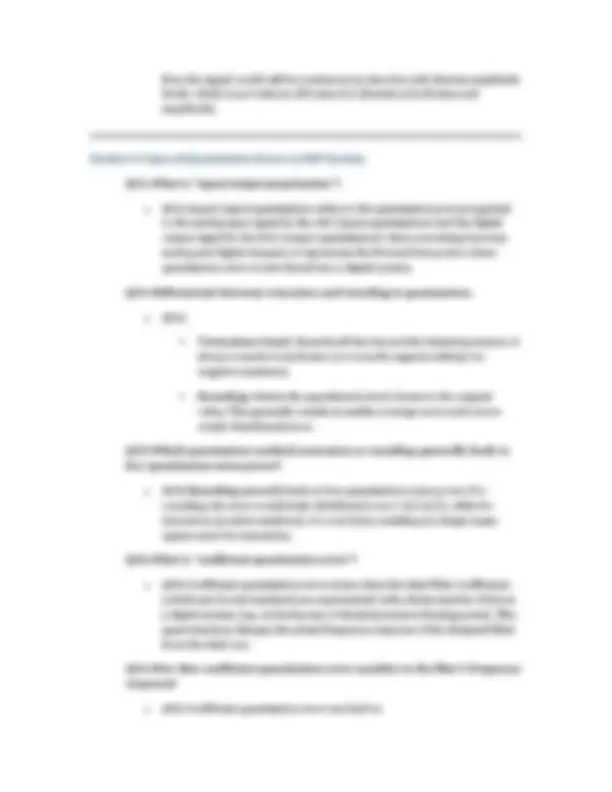
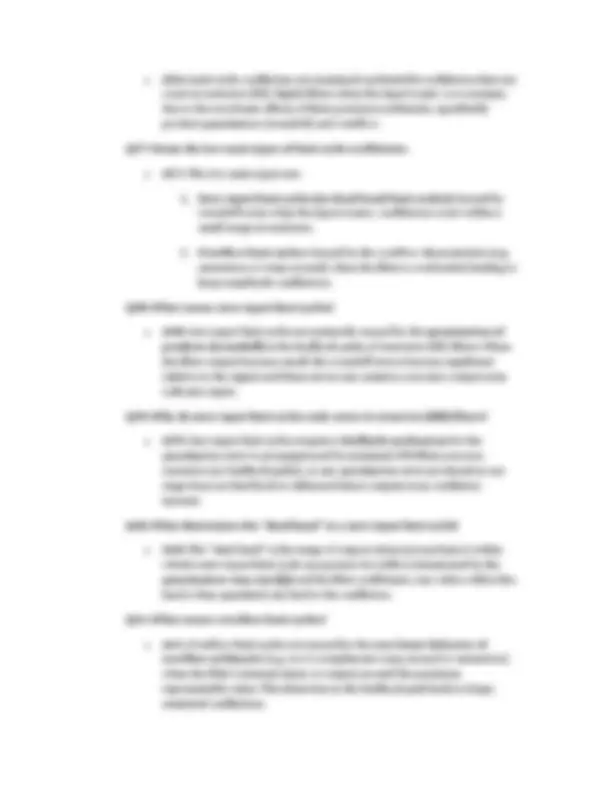
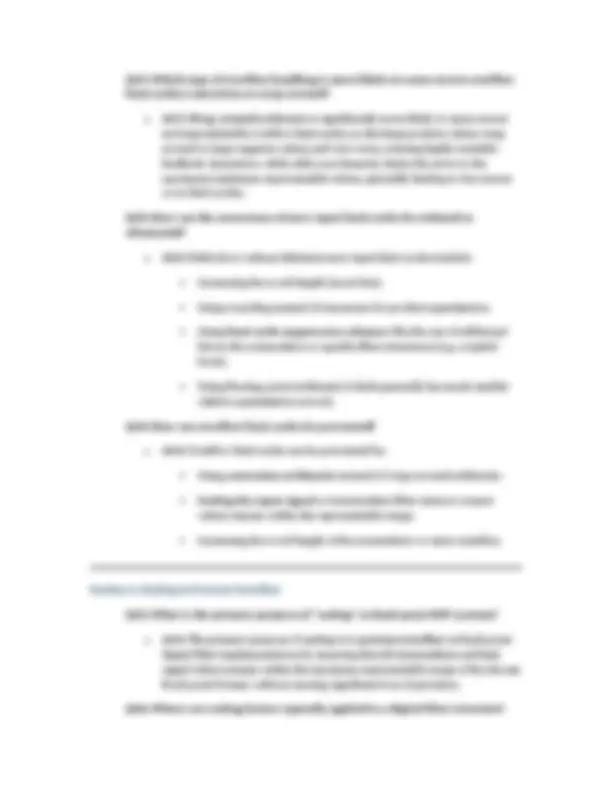
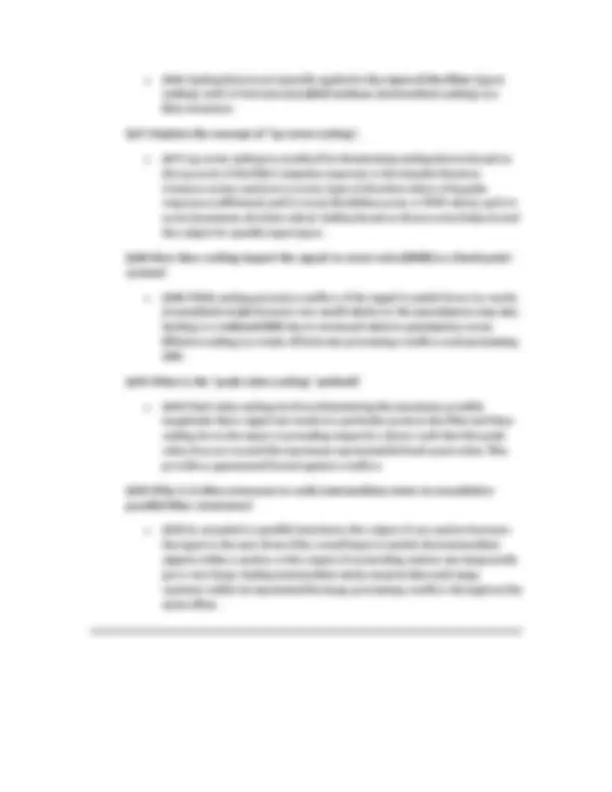


Study with the several resources on Docsity

Earn points by helping other students or get them with a premium plan


Prepare for your exams
Study with the several resources on Docsity

Earn points to download
Earn points by helping other students or get them with a premium plan
Community
Ask the community for help and clear up your study doubts
Discover the best universities in your country according to Docsity users
Free resources
Download our free guides on studying techniques, anxiety management strategies, and thesis advice from Docsity tutors
The content consists of short questions and answers related to the topic Quantization and Numerical Representation in the subject Digital Signal Processing
Typology: Exams
1 / 10

This page cannot be seen from the preview
Don't miss anything!







Prepared by Abhijit Sujan S Digital Signal Processing: Quantization & Number Representation (2-Mark Q&A) Section 1: Number Representation Q1: What is fixed-point number representation? o A1: Fixed-point representation is a method of representing real numbers where the position of the radix point (decimal point) is fixed. It is commonly used in digital signal processors (DSPs) due to its simplicity, speed, and lower hardware cost compared to floating-point. The number of bits allocated for the integer and fractional parts is predetermined. Q2: Differentiate between signed magnitude and two's complement fixed- point representation. o A2: In signed magnitude , the most significant bit (MSB) represents the sign (0 for positive, 1 for negative), and the remaining bits represent the magnitude. In two's complement , positive numbers are represented as usual, while negative numbers are represented by taking the two's complement of their positive counterpart. Two's complement simplifies arithmetic operations, especially addition and subtraction, as sign handling is inherent. Q3: What is floating-point number representation? o A3: Floating-point representation is a method for representing real numbers that provides a wider dynamic range than fixed-point. It represents a number as a mantissa (or significand) multiplied by a base (usually 2) raised to an exponent. This is analogous to scientific notation. Q4: Name the three main components of a floating-point number. o A4: The three main components are:
finer resolution, smaller quantization error, and a higher signal-to- quantization noise ratio (SQNR). Q15: What is "quantization noise"? o A15: Quantization noise is the error introduced during the quantization process. It is the difference between the original analog sample value and its quantized digital representation. It is often modeled as an additive, uniformly distributed random noise signal with a peak-to-peak amplitude equal to the quantization step size Q. Q16: Is quantization noise signal-dependent or signal-independent? Briefly explain. o A16: For a uniformly distributed input signal, quantization noise is generally considered signal-independent. However, for certain periodic or low- amplitude input signals, the quantization error can become correlated with the signal, leading to harmonic distortion rather than pure noise. Q17: What is the ideal probability distribution of quantization error for a large dynamic range input? o A17: For a large dynamic range input signal that traverses many quantization levels, the ideal probability distribution of the quantization error is often approximated as a uniform distribution over the range [−Q/2,Q/2] (for rounding) or [0,Q] (for truncation, if only positive values are considered). Q18: What is the formula for the power of quantization noise (Pe) for rounding, assuming a uniform distribution? o A18: For quantization error uniformly distributed over [−Q/2,Q/2], the power of quantization noise is Pe=Q2/12. Q19: What is the approximate formula for the Signal-to-Quantization Noise Ratio (SQNR) for an N-bit ADC? o A19: The approximate SQNR for an N-bit ADC (in dB) is given by SQNR≈6.02N+1.76 dB. This formula assumes a sinusoidal input signal that spans the full dynamic range of the ADC. Q20: Why is sampling followed by quantization in an ADC, and not the other way around? o A20: Sampling converts a continuous-time signal into a discrete-time signal, but its amplitude remains continuous. Quantization then discretizes these continuous amplitudes into a finite set of levels. If quantization were done
first, the signal would still be continuous in time but with discrete amplitude levels, which is not what an ADC aims for (discrete in both time and amplitude). Section 3: Types of Quantization Errors in DSP Systems Q21: What is "input/output quantization"? o A21: Input/output quantization refers to the quantization process applied to the analog input signal by the ADC (input quantization) and the digital output signal by the DAC (output quantization) when converting between analog and digital domains. It represents the first and last points where quantization error is introduced into a digital system. Q22: Differentiate between truncation and rounding in quantization. o A22: ▪ Truncation: Simply discards all bits beyond the desired precision. It always rounds towards zero (or towards negative infinity for negative numbers). ▪ Rounding: Selects the quantization level closest to the original value. This generally results in smaller average error and a more evenly distributed error. Q23: Which quantization method, truncation or rounding, generally leads to less quantization noise power? o A23: Rounding generally leads to less quantization noise power. For rounding, the error is uniformly distributed over [−Q/2,Q/2], while for truncation (positive numbers), it's over [0,Q], resulting in a larger mean square error for truncation. Q24: What is "coefficient quantization error"? o A24: Coefficient quantization error arises when the ideal filter coefficients (which can be real numbers) are represented with a finite number of bits in a digital system (e.g., in fixed-point or limited precision floating-point). This approximation changes the actual frequency response of the designed filter from the ideal one. Q25: How does coefficient quantization error manifest in the filter's frequency response? o A25: Coefficient quantization error can lead to:
Q31: Describe "wrap-around arithmetic" as a consequence of overflow. o A31: Wrap-around arithmetic is an uncontrolled consequence of overflow in two's complement arithmetic where, if the result exceeds the representable range, the most significant bit is effectively lost, and the value "wraps around" from positive to negative, or negative to positive. For example, 7+2=−7 in a 4-bit two's complement system. This can lead to severe distortion. Q32: Why is overflow a more significant problem in IIR filters than in FIR filters? o A32: In IIR filters, feedback loops exist. If an overflow occurs in a feedback path, the error can propagate and be amplified, potentially leading to instability or very large, erroneous outputs. FIR filters, being non-recursive, do not have this feedback, so overflow errors are generally confined to the current output sample and do not accumulate or cause instability. Q33: What is "summation quantization"? o A33: Summation quantization refers to the quantization errors that occur when summing multiple numbers, especially in the accumulator of a digital filter. Even if individual products are correctly quantized, the sum itself might exceed the accumulator's word length or introduce additional quantization errors if the sum is subsequently requantized. Q34: How does the order of summation affect quantization noise in a filter? o A34: The order of summation can affect the accumulation of quantization noise. For example, in a direct form filter, summing small numbers before large numbers can reduce the chance of overflow. Rearranging the order of additions can sometimes mitigate error build-up, though direct form implementations generally have high noise gain from quantization. Q35: What is the primary difference in the effect of coefficient quantization error between FIR and IIR filters? o A35: For FIR filters , coefficient quantization primarily affects the frequency response shape (e.g., transition band, ripple). For IIR filters , coefficient quantization can not only distort the frequency response but, more critically, can also shift poles outside the unit circle, making the filter unstable. Section 4: Limit Cycle Oscillations Q36: What are "limit cycle oscillations" in digital filters?
o A36: Limit cycle oscillations are sustained, undesirable oscillations that can occur in recursive (IIR) digital filters when the input is zero or a constant, due to the non-linear effects of finite-precision arithmetic, specifically product quantization (roundoff) and overflow. Q37: Name the two main types of limit cycle oscillations. o A37: The two main types are:
o A46: Scaling factors are typically applied at the input of the filter (input scaling), and/or between cascaded sections (intermediate scaling) in a filter structure. Q47: Explain the concept of "Lp-norm scaling". o A47: Lp-norm scaling is a method for determining scaling factors based on the Lp norm of the filter's impulse response or the transfer function. Common norms used are L1 norm (sum of absolute values of impulse response coefficients) and L2 norm (Euclidean norm or RMS value), and L∞ norm (maximum absolute value). Scaling based on these norms helps bound the output for specific input types. Q48: How does scaling impact the signal-to-noise ratio (SNR) in a fixed-point system? o A48: While scaling prevents overflow, if the signal is scaled down too much, its amplitude might become very small relative to the quantization step size, leading to a reduced SNR due to increased relative quantization noise. Effective scaling is a trade-off between preventing overflow and maximizing SNR. Q49: What is the "peak value scaling" method? o A49: Peak value scaling involves determining the maximum possible magnitude that a signal can reach at a particular point in the filter and then scaling down the input or preceding stages by a factor such that this peak value does not exceed the maximum representable fixed-point value. This provides a guaranteed bound against overflow. Q50: Why is it often necessary to scale intermediate states in cascaded or parallel filter structures? o A50: In cascaded or parallel structures, the output of one section becomes the input to the next. Even if the overall input is scaled, the intermediate signals within a section or the output of a preceding section can temporarily grow very large. Scaling intermediate states ensures that each stage operates within its representable range, preventing overflow throughout the entire filter.